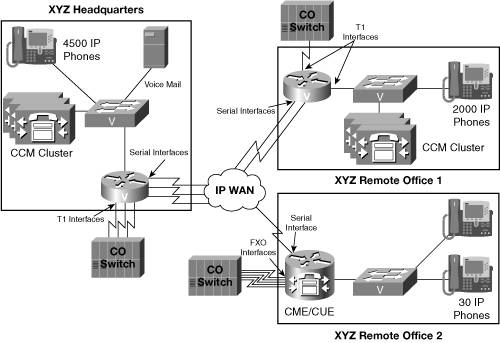Case Study: Your Turn to Do an Extreme Phone System Makeover
| Based on your previous design of XYZ Company's phone system (as discussed in the previous chapter's case study) and based on your recommendations for the XYZ Company to migrate to a VoIP network, the XYZ Company asks you to provide it with yet another design. This time, the XYZ Company wants you to diagram how its telephony network would look with all of its phone switches (that is, PBXs and key system) replaced with Cisco CallManager servers and/or CME routers. Recall the information in Table 1-3 (reproduced here in Table 4-5) concerning the XYZ Company from the case study in Chapter 1, "Touring the History Museum of Telephony."
Based on these criteria, design a pure IP telephony solution using the hardware and software products discussed in this chapter. Diagram and discuss your answer. Design Diagram for XYZ Company:Design Description for XYZ Company:____________________________________________________________ ____________________________________________________________ ____________________________________________________________ ____________________________________________________________ ____________________________________________________________ ____________________________________________________________ ____________________________________________________________ ____________________________________________________________ ____________________________________________________________ ____________________________________________________________ ____________________________________________________________ ____________________________________________________________ ____________________________________________________________ ____________________________________________________________ ____________________________________________________________ ____________________________________________________________ ____________________________________________________________ Suggested SolutionMultiple design solutions satisfy the design requirements for this case study. The following suggested solution represents only one solution. So, don't be concerned if your solution varies from the suggested solution. The XYZ Company wishes to replace its existing PBXs and key system with IP telephony components. The design from Chapter 3, "Paving the Pathway to a Voice over IP Network," introduced voice-enabled routers into the XYZ Company's network. We can now add Ethernet switches to the design and connect the voice-enabled routers and new IP phones to the Ethernet switches. We can configure the Ethernet switches to provide inline power to the attached IP phones and to provide auxiliary VLAN information to the IP phones. We can remove the PBXs and key system. Because the XYZ Headquarters contains 4,500 IP phones, we select a CCM cluster for the headquarters location, using the Cisco 2:1 redundancy design, which requires a total of four CCM servers using MCS-7835H server platforms. XYZ Remote Office 1 requires support for 2000 IP phones. A three-server CCM cluster, using MCS-7835H server platforms, meets this remote office's requirements. XYZ Remote Office 2 only requires support for 30 IP phones. 30 IP phones probably don't justify the purchase of a CCM cluster. These 30 IP phones could register with the centralized CCM cluster (that is, the CCM cluster located at XYZ Headquarters). However, for redundancy and scalability reasons, this design recommends the use of a CME router at XYZ Remote Office 2. A 2610XM router supports up to 36 IP phones. Therefore, this design specifies that the 30 IP phones at XYZ Remote Office 2 register with a 2610XM-based CME router. The XYZ Company's design requirements also called for voice mail support for all locations. Cisco CallManager interoperates with many legacy voice mail systems, even in the absence of a PBX. Therefore, the XYZ Headquarters and XYZ Remote Office 1 continue to use existing voice mail facilities. However, we decide to purchase a Cisco Unity Express (asynchronous interface module - Cisco Unity Express [AIM-CUE]) card to mount on the router's motherboard to support voice mail for XYZ Remote Office 2. The AIM-CUE supports up to 50 voice mail boxes. The case study in Chapter 3 provisioned WAN links between XYZ locations. Therefore, the only remaining design requirement involves support for conference calling. The CCM environment supports either hardware-based or software-based conference calling. With hardware-based conference calls, DSPs, located in routers or switches, provide the processing power to mix multiple audio streams together. Software-based conference calling uses a CCM server to mix audio streams. This case study requires support for a conference call with 20 participants. A dedicated CCM server supports up to 128 conference participants. Therefore, this design specifies a software-based conference solution, using CCM servers for the XYZ Headquarters and XYZ Remote Office 1 locations. The XYZ Remote Office 2 location can use hardware resources (that is, DSPs) installed in the CME router for conferenc calling support. The suggested solution, as shown in Figure 4-32, represents a distributed deployment design, with one slight variation. XYZ Remote Office 2 uses a CME router, as opposed to a CCM cluster. Figure 4-32. XYZ Company's Suggested Solution |
EAN: 2147483647
Pages: 138